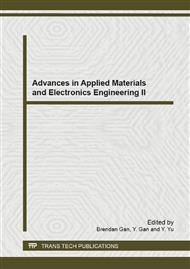[1]
Iijima S., Helical microtubules of graphitic carbon. Nature, 1991, 354: 56-58.
DOI: 10.1038/354056a0
Google Scholar
[2]
Ye SF, Wu YH, Hou ZQ, Zhang QQ. ROS and NF-kappa B are involved in upregulation of IL-8 inA549 cells exposed to multi-walled carbon nanotubes. Biochemical and Biophysical ResearchCommunications. 2009; 379: 643-8.
DOI: 10.1016/j.bbrc.2008.12.137
Google Scholar
[3]
Brown DM, Kinloch IA, Bangert U, Windle AH, Walter DM, Walker GS, et al. An in vitro study of the potential of carbon nanotubes and nanofibres to induce inflammatory mediators and frustrated phagocytosis. Carbon. 2007; 45: 1743-56.
DOI: 10.1016/j.carbon.2007.05.011
Google Scholar
[4]
Schrand AM, Dai L, Schlager JJ, Hussain SM, Osawa E. Differential biocompatibility ofcarbon nanotubes and nanodiamonds. Diamond and Related Materials. 2007; 16: 2118-23.
DOI: 10.1016/j.diamond.2007.07.020
Google Scholar
[5]
Garza KM, Soto KF, Murr LE. Cytotoxicity and reactive oxygen species generation from aggregated carbon and carbonaceous nanoparticulate materials. International Journal of Nanomedicine. 2008; 3: 83-94.
DOI: 10.2147/ijn.s2464
Google Scholar
[6]
Jia G, Wang HF, Yan L, Wang X, Pei RJ, Yan T, et al. Cytotoxicity of carbon nanomaterials: Single-wall nanotube, multi-wall nanotube, and fullerene. Environmental Science & Technology. 2005; 39: 1378-83.
DOI: 10.1021/es048729l
Google Scholar
[7]
Pacurari M, Yin XJ, Ding M, Leonard SS, Schwegler-Berry D, Ducatman BS, et al. Oxidative and molecular interactions of multi-wall carbon nanotubes (MWCNT) in normal and malignant human mesothelial cells. Nanotoxicology. 2008; 2: 155-70.
DOI: 10.1080/17435390802318356
Google Scholar
[8]
Zhang XK, Wang XF, Lu QH, Fu CL. Influence of carbon nanotube scaffolds on human cervical carcinoma HeLa cell viability and focal adhesion kinase expression. Carbon. 2008; 46: 453-60.
DOI: 10.1016/j.carbon.2007.12.015
Google Scholar
[9]
Tabet L, Bussy C, Amara N, Setyan A, Grodet A, Rossi M, et al. Adverse effects of industrial multiwalled carbon nanotubes on human pulmonary cells. Journal of Toxicology and Environmental Health-Part a-Current Issues. 2009; 72: 60-73.
DOI: 10.1080/15287390802476991
Google Scholar
[10]
Herzog E, Byrne HJ, Casey A, Davoren M, Lenz A-G, Maier KL, et al. SWCNT suppress inflammatory mediator responses in human lung epithelium in vitro. Toxicology and Applied Pharmacology. 2009; 234: 378-90.
DOI: 10.1016/j.taap.2008.10.015
Google Scholar
[11]
Tyshenko MG. Medical nanotechnology using genetic material and the need for precaution in design and risk assessments. International Journal of Nanotechnology. 2008; 5: 116-23.
DOI: 10.1504/ijnt.2008.016551
Google Scholar
[12]
Simon-Deckers A, Gouget B, Mayne-L'Hermite M, Herlin-Boime N, Reynaud C, Carriere M. In vitro investigation of oxide nanoparticle and carbon nanotube toxicity and intracellular accumulation in A549 human pneumocytes. Toxicology. 2008; 253: 137-46.
DOI: 10.1016/j.tox.2008.09.007
Google Scholar
[13]
Zhang DW, Yi CQ, Zhang JC, Chen Y, Yao XS, Yang MS. The effects of carbon nanotubes on theproliferation and differentiation of primary osteoblasts. Nanotechnology. 2007; 18: 75102.
DOI: 10.1088/0957-4484/18/47/475102
Google Scholar
[14]
Sato Y, Yokoyama A, Shibata K, Akimoto Y, Ogino S, Nodasaka Y, et al. Influence of length on cytotoxicity of multi-walled carbon nanotubes against human acute monocytic leukemia cell line THP-I in vitro and subcutaneous tissue of rats in vivo. Molecular Biosystems. 2005; 1: 176-82.
DOI: 10.1039/b502429c
Google Scholar
[15]
Wick P, Manser P, Limbach LK, Dettlaff-Weglikowska U, Krumeich F, Roth S, et al. The degree and kind of agglomeration affect carbon nanotube cytotoxicity. Toxicology Letters. 2007; 168: 121-31.
DOI: 10.1016/j.toxlet.2006.08.019
Google Scholar
[16]
Tian FR, Cui DX, Schwarz H, Estrada GG, Kobayashi H. Cytotoxicity of single-wall carbon nanotubes on human fibroblasts. Toxicology in Vitro. 2006 ; 20: 1202-12.
DOI: 10.1016/j.tiv.2006.03.008
Google Scholar
[17]
Pulskamp K, Worle-Knirsch JM, Hennrich F, Kern K, Krug HF. Human lung epithelial cells show biphasic oxidative burst after single-walled carbon nanotube contact. Carbon. 2007; 45: 2241-9.
DOI: 10.1016/j.carbon.2007.06.054
Google Scholar
[18]
Worle-Knirsch JM, Pulskamp K, Krug HF. Carbon nanotubes hoax scientists in viability assays. Nano Letters. 2006; 6: 1261-8.
DOI: 10.1021/nl060177c
Google Scholar
[19]
Belyanskaya L, Manser P, Spohn P, Bruinink A, Wick P. The reliability and limits of the MTT reduction assay for carbon nanotubes-cell interaction. Carbon. 2007; 45: 2643-8.
DOI: 10.1016/j.carbon.2007.08.010
Google Scholar


